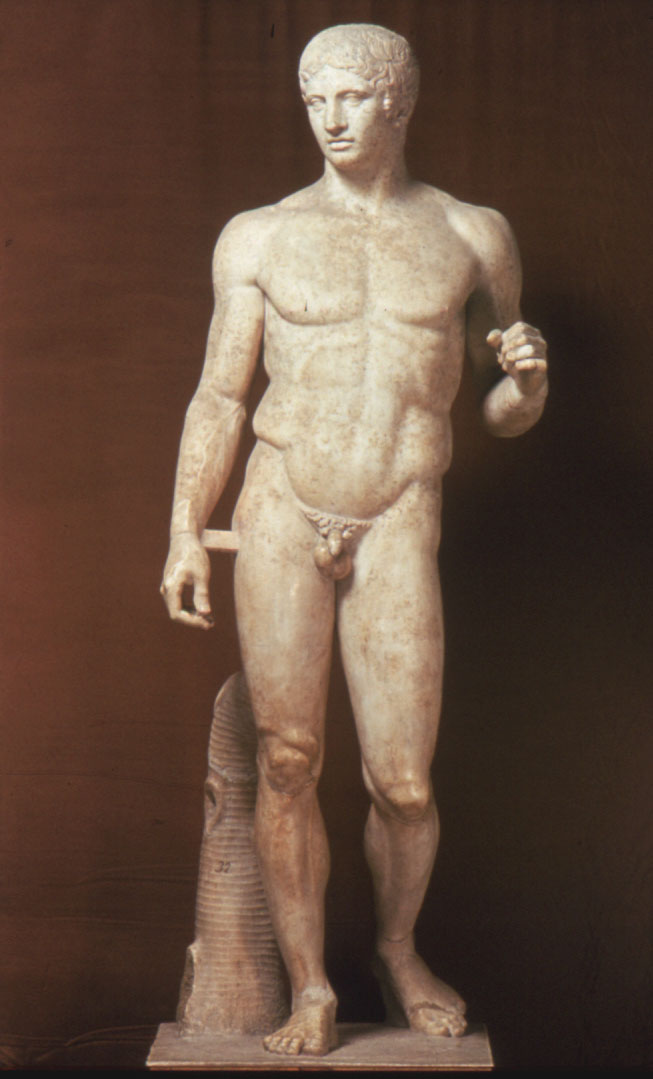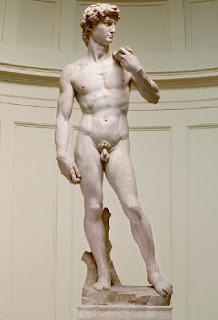Wednesday, April 22nd, 2009
The Cyclical Nature of Art
When I was in college, one of my professors explained her theory that art is cyclical in nature. Over the centuries, there are certain themes and styles in art that keep emerging and fading in popularity. I have often thought about this theory in regards to the Classical and Baroque styles. Although this theory can apply to different types of art, I am in the mood for looking at sculpture, so I’ll only mostly use sculptural examples.
In early Greece, the serene, harmonious Classical style pervaded the artistic scene:
 Polykleitos, “Spear-bearer” (Doryphoros), original dated c. 450-440 BC.
Polykleitos, “Spear-bearer” (Doryphoros), original dated c. 450-440 BC.
 Athena Battling Alkyoneos, Detail of the Gigantomachy Freize from the Altar of Zeus (Pergamon, Turkey, c. 175 BC).
Athena Battling Alkyoneos, Detail of the Gigantomachy Freize from the Altar of Zeus (Pergamon, Turkey, c. 175 BC).
The Romantic movement began about the same time and can be interpreted as a continuation of this cycle. In a way, the Romantics reacted against Neoclassicism by favoring drama and emotion over the serenity. This painting by Géricault focuses on dramatic subject matter by depicting a real-life event of shipwrecked passengers that were on the boat “Medusa.” A shortage of lifeboats caused 150 passengers to build a raft, and survivors resorted to cannibalism in order to stay alive on the open sea. (You can read more of the story here.) Can you see how this subject matter is dramatic? To heighten the drama, Gericault depicted an emotional moment when the survivors spot their rescue ship in the distance. Géricault even follows the same dramatic diagonal compositions that were favored in earlier dramatic styles:
 Géricault, Raft of the “Medusa”, 1818-19
Géricault, Raft of the “Medusa”, 1818-19
I’m curious to see if art will ever return back to this cycle. Since the 19th and 20th centuries, art has just exploded into different types of media and styles. Have we left traditional cycles altogether? It is interesting to think about what art will be like in a hundred years or so.
What do you think about the future of art? Have you observed any other types of artistic cycles besides this one?



do you think that (western european) art repeated this cycle in the middle ages as well?
I think we’re progressing toward a similar swing, though maybe on a different level. The 20th century exploded in all kinds of directions because originality was the most valued principle – doing things that nobody had ever done before. In the 20th century, the artists in history who were important were the ones who changed things (which is a lot easier to spot in retrospect than it is in the present). Art was all about progress and development, modernity, avant-garde – the cutting edge.
But I think now, we’re at a point where we’re getting tired of everyone being so “new” all the time, and frankly, we’re running out of new things to do. So, my prediction is that there will be a return of the “neo-classical” spirit – though probably not the romanesque style – of returning to the solidarity of the past, rather than experimenting with the future.
I hadn’t thought much about the Middle Ages in regards to this cycle, but now that I think about it, there can be some applications because of Charlemagne’s interest in classicism and the Roman Empire.
It’s interesting to compare Carolingian architecture (I’m specifically thinking of the Palatine Chapel in Aachen) to later Gothic cathedrals. I think that the mysticism and grandeur (i.e. “drama”, if you will) of Gothic cathedrals could be a cyclical counterpart for the classicism of the “Carolingian Renaissance.”
What do YOU think, Zillah? You’re the medieval expert…
GermyB, I’d like to see a return to solidarity. I hope that’s the case. But that’s because I love tradition and the older styles.
Are you getting tired of the “new” and cutting-edge stuff?
Yes and no. I think the 20th century is really fascinating, and I love the freedom it has created for artists to choose the artistic method that best expresses their idea, rather than being shackled to tradition and custom. But I do think that originality will become less of a virtue. It’s like we’re becoming more of an adult – rather than just celebrating our new-found freedom by doing all those things we weren’t allowed to do before, we’re settling down, and growing up. The freedom is still there – its just not so central. Maybe. I guess that’s how I feel. I’m valuing originality less than I used to. And I think with time, that’s how things will go in western contemporary art.
I think that it certainly applies, but I’m not an art historian, so I wanted to make sure that my biases weren’t getting in the way. 🙂
I think that one could characterize the transition from Carolingian and Romanesque to Gothic architecture/sculpture as part of the cycle you describe (at least in certain geographic areas, since English perpendicular is quite restrained when compared to French flamboyant). Perhaps the dramatic swing of the cycle culminates in Strausbourg and the tomb sculpture of Philippe Pot. (You see the same trend from restraint (despite the love of intricate interlocking designs) to embellishment and drama in manuscript illumination.)
Of course, there are notable differences from these broad descriptions, but it certainly is fun to generalize 1000 years. 😉
Wow, so interesting! I think it’d be very cool to see the cycle come back. I think the classical style is really beautiful.
And the story of the raft of Medusa was so interesting to read.
P.S. I found it so interesting, that I went to wikipedia to read about the Raft of Medusa. That’s really interesting stuff. I know that wikipedia can be questionable, so I was wondering what your thoughts on the entry were?
(can be seen at: http://en.wikipedia.org/wiki/Raft_of_the_Medusa)
Zillah, you bring up a good point that I forgot to mention in this post. I am obviously making gross generalizations, and there will definitely be exceptions to this cyclical pattern. But it is fun to find similar themes that span across centuries. And although generalizations can contain an element of error, I also think there is value in finding commonality in art/artistic periods through broad descriptions.
Oh, and I like your thinking about the dramatic cycle culminating in Strasbourg Cathedral. The “Death of the Virgin” tympanum (over the south transept) is full of emotional drama and passion. Good call.
Emilee, I hadn’t seen that Wikipedia entry before. From what I can tell, at this point it appears to be accurate. Luckily, Raft of the Medusa is a very popular painting and has been widely researched, so people would quick to correct errors that appear on there. The painting is really fascinating, isn’t it?
Gericault was a really interesting painter. He also painted a series of portraits of insane people. (You can see how he was a true Romantic since he was drawn to emotional, dramatic, horrifying subject matter…)